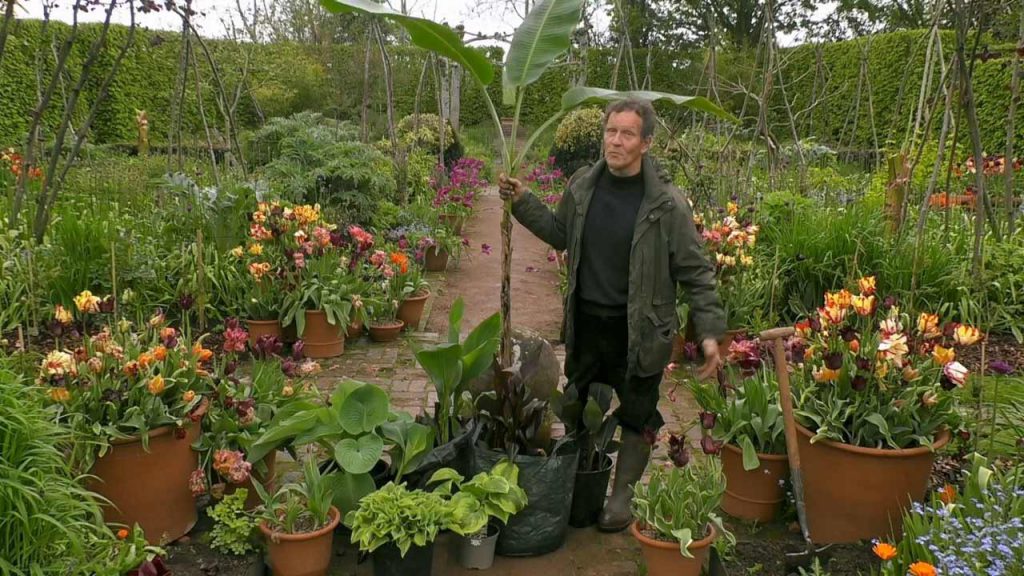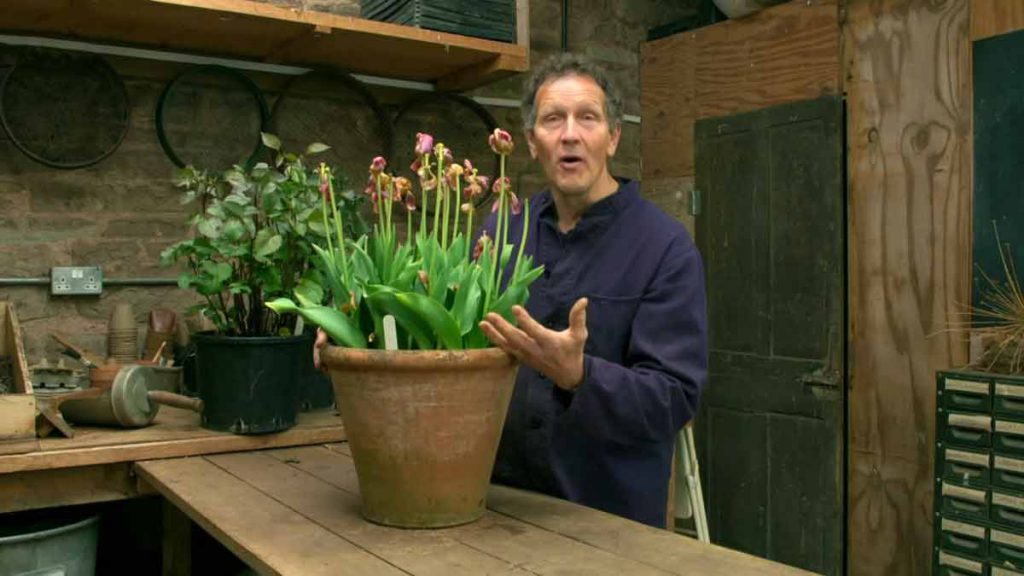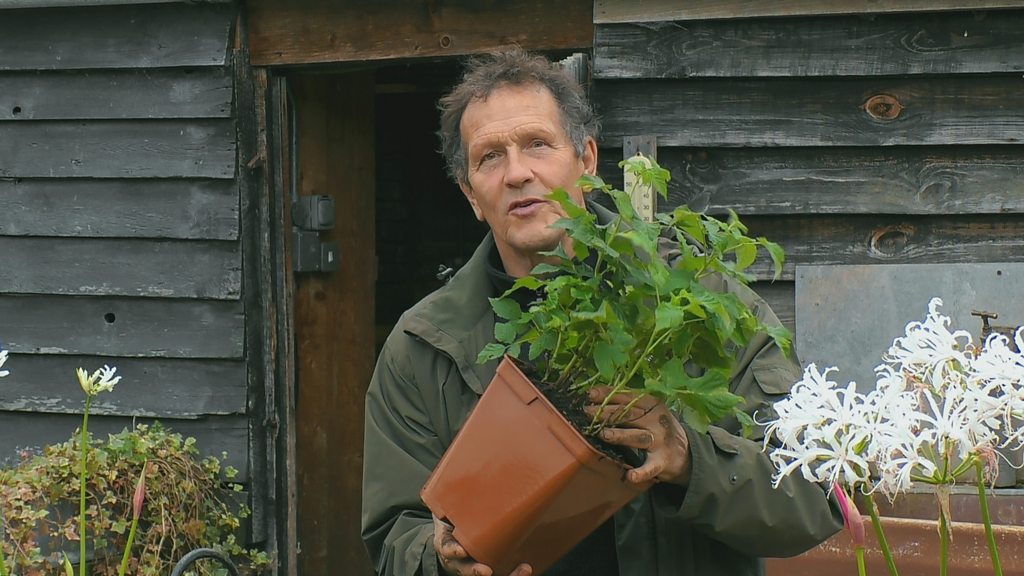Gardeners’ World 2021 episode 11: Monty gives advice on plants to use for foliage with tropical proportions and shows us how to plant them to suit their needs, gives a masterclass on herbs to grow in shady areas of the garden and sows sweetcorn and cucumbers for summer harvests.
Arit Anderson continues her investigation into the use of peat as she talks to the people involved in the manufacture of compost as well as growers and consumers. In Cheshire, an enthusiast aims to have a clematis in flower every day of the year in his garden and has amassed a collection of over 150 plants in his quest for floral abundance.
One of the most vibrant of spring flowering plants is the euphorbia, and Carol Klein is at Oxford Botanic Garden to explore their national collection. We also find out what viewers have been getting up to in their own gardens.
Gardeners’ World 2021 episode 11
How to grow bananas
Bananas (Musa and Ensete spp.) produce large, elegant leaves and the occasional bunch of fruits, which certainly make a majestic addition to any garden or conservatory. Although they are tender plants, some species are hardy enough to leave outside over winter, especially in the milder parts of the UK, so they are worth experimenting with in the garden.
Choose a sheltered site, with the site sloping away slightly from the plant to avoid creating a frost pocket. Shelter from the wind is also essential to prevent leaves being shredded. Plant in late spring, in a well-drained soil, enriched with organic matter (such as garden compost). Once plants are established, water and feed generously to get the best foliage.
Hardier species, such as Musa basjoo, can be left in situ over winter, and it is generally recommended to wrap plants to protect from cold weather. Although this is something you can experiment with in your garden. See our advice in overwintering tender plants: wrapping for further information, and step-by-step instructions on wrapping a banana.
Smaller banana species make ideal container plants, which can be placed outdoors for the summer and brought indoors over winter. Grow in a loam-based compost, such as John Innes No. 3 with extra grit (30 percent by volume).
Container-grown plants need ample watering during spring and summer months. Feed at weekly intervals during the spring and summer with a general-purpose liquid feed, or mix a controlled-release fertiliser into compost when potting.
In autumn, reduce watering and feeding, watering only when on the dry side in winter.Tender plants should be brought in when temperatures fall below 14ºC (57ºF) and overwintered in a frost-free greenhouse or conservatory. Pot on in spring once a year, or every other year. Size and vigour increases with size of container. Increase pot size by 5-7.5cm (2-3in) initially. Once established in 30cm (10in) pots, increase size by 10-15cm (4-6 inches) every two to three years.
How to grow hostas
These shade-loving plants are primarily grown for their beautiful foliage. There’s a vast range of cultivars to choose from, with leaves in all shades of green, as well as dusky blues and acid yellows, sometimes variegated or flashed with cream or gold, ruffled, smooth or distinctively ribbed. Many also produce small trumpet-shaped mauve or white flowers in summer. Hostas are notoriously irresistible to slugs and snails, but are also much loved by gardeners, who often amass large collections.
Hostas are one of the best foliage plants. They are easy to-grow-plants and long-lived.
There is a wide range of hostas, which vary in leaf shape, size and colour. With a such huge range of leaf shapes, sizes and colours, choosing a hosta is mainly a matter of personal taste. However, it’s also wise to match the plants to the conditions you have in your garden. In general, most thrive in moist soil in light to medium shade. However, blue-leaved hostas flourish in light shade, while yellow-leaved ones prefer some sun.
Miniature types such as ‘Blue Mouse Ears’ or ‘Pandoras Box’ are a good choice if space is tight or for containers. Most also produce clusters of flowers in shades of white, lavender and purple on tall stems.
Growing and pruning figs – Gardeners’ World 2021 episode 11
Figs (Ficus carica) are large shrubs or small trees grown for their succulent fruit and beautiful architectural foliage. They thrive in the garden, in a container, in glasshouses or trained against a wall. Figs come from warm Mediterranean climates and in southern regions will thrive in a sunny and sheltered position with well-drained soil.
Although figs can cope with dry conditions, drought can cause fruit to drop prematurely, especially if the developing fruit suffers from lack of water early in the growing season. Water plants regularly during the summer season, but do not give them too much or water them erratically while the fruit is ripening, as this may cause the fruit to split. Container grown plants are more vulnerable to lack of water.
Figs grown on fertile soils seldom require additional feeding in spring but when fruits appear feed weekly with a high-potassium liquid plant food (such as tomato fertiliser). If grown on poor soils and/or with root restriction, weak trees may benefit from an early spring application of 70g (2oz) of a balanced granular fertiliser (such as Growmore or fish, blood and bone). Overfeeding can lead to excessive vegetative growth at the expense of fruiting.
Weak growth may also be due to lack of water caused by root restriction. Where this appears to be the case, mulch with 2.5-5cm (1-2in) of garden compost or composted bark.





Pingback: Gardeners’ World 2021 episode 12 — HDclump — Gardeners’ World 2021